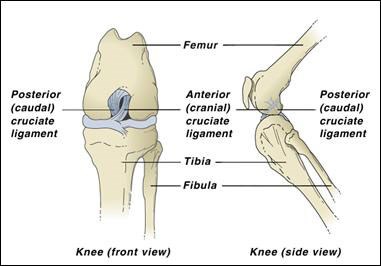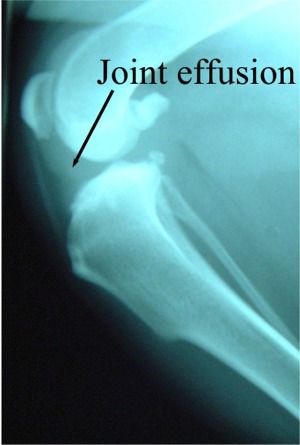I pulled my knee!
What is a cruciate injury?
Today's blog discuss a common knee injury in dogs: the cruciate ligament injury. This is the most common knee injury in dogs. This injury can happen in any age, breed, and size of dog but is more common in large breed dogs such as Labs, Goldens, Rottweillers, and Mastiffs. Small breed dogs such as Chihuahuas, Havanese, or Malteses have had the same injury too. In these breeds it is sometimes related to a luxating patella or wiggly knee cap. The cruciate ligament tear is similar to an ACL tear in people, which is common in athletes.

The cruciate ligament is part of a pair of ligaments that hold the knee joint together. This pair forms an "X" in the joint and stabilizes the femur (the bone inside the thigh) in relation to the tibia and fibula (the "shin" bones in the lower leg). In some dogs, over time the ligaments degenerate and can stretch. Some dogs stretch the ligament acutely while chasing a squirrel and turning abruptly, while other dogs can injure themselves on ice, rocks, or just running around. The two injuries to the ligament are a pulled or stretched cruciate ligament and a completely torn cruciate ligament.
If your dog pulls or tears his or her cruciate ligament you may notice them favouring that limb, bearing less weight on it, or "toe-touching" (walking tip-toed on the affected limb). Some dogs may lift the limb up completely, refusing to bear any weight on it. If you notice your dog not bearing weight appropriate on one of his or her limbs, it is important to bring them in to be assessed by a veterinarian. If you can, it is helpful to record a video on him or her walking or trotting at home.
In your appointment we will examine your dog and determine if the injury is in the cruciate ligament. Depending on the size of your dog and the degree of the injury, usually sedation is necessary in order to relax the muscles and fully assess the knee joint. We do a special test on the knee called a "drawer test" - this test is where a veterinarian grasps the femur (thigh bone) in one hand and the tibia (shin bone) in the other hand and moves the tibia back and forth relative to the femur. This back and forth motion is similar to opening a drawer in a dresser, that's why it is called the drawer test. X-rays are also done while your dog is sedated in order to assess the health of the joint and determine if there is any swelling, excess fluid (joint effusion), new bone formation, or arthritic changes in the joint.

Depending on the degree of the injury and the size of your dog, there are options for medical management (strict rest and anti-inflammatory medication) or surgery. The length of rest, type of medication, and surgical options vary depending on the breed of dog and type of injury, so it is best to discuss these in person.